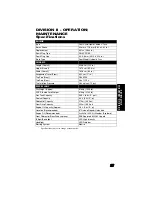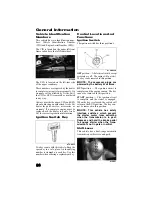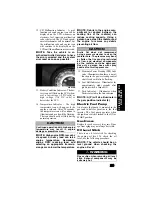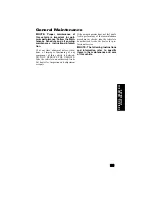
22
Vehicle Operation
Crossing Obstacles
Crossing obstacles can be hazardous.
There is always the possibility of the
vehicle tipping. If you cannot go around
an obstacle, follow these guidelines:
1. Stop the vehicle and set the parking
brake. Go out to inspect the obstacle
thoroughly from both your approach
side and the exit side. If you believe
you can cross the obstacle safely,
select four-wheel drive (4WD).
NOTE: Selecting the LOCK posi-
tion on the differential lock control
may be beneficial; however, steer-
ing effort will be greatly increased.
2. Approach the obstacle as close as
possible to 90° to minimize vehicle
tipping.
3. Keep speed slow enough to maintain
control but fast enough to maintain
momentum.
4. Use only enough power to cross the
obstacle but still give yourself plenty
of time to react to changes in condi-
tions. Crawl over the obstacle.
NOTE: If there is any question
about your ability to cross the
obstacle safely, you should turn
around if the ground is flat and you
have room or back up until you find
a less difficult path.
Driving in Reverse
When operating in reverse, avoid sharp
turns and backing down a hill. When
using reverse, follow these guidelines:
1. Back up slowly. It’s hard to see
behind you.
NOTE: Avoid sudden braking
while backing up.
2. If possible, it is advisable to have
someone “spotting” for you while
backing up.
3. If you are unsure of what is behind
the vehicle, set the parking brake and
get out and inspect the area behind.
Skidding or Sliding
If you lose control after hitting sand, ice,
mud, or water, follow these guidelines:
1. Turn the steering wheel into the direc-
tion of the slide.
2. Keep your foot off the brake until
you’re out of the skid.
3. Stop and shift into four-wheel drive.
Crossing Water
This vehicle can only operate in water up
to its floorboard. Stay away from fast
moving rivers. This vehicle’s tires can be
buoyant. In deep water, the vehicle may
lose traction due to floating.
1. Physically check the depth and cur-
rent of the water, especially if you
can’t see the bottom. Also, check for
boulders, logs, or any other hidden
obstacles.
2. Keep speed slow while maintaining
momentum.
3. Make sure you have a way out on the
other side of the water.
4. Once you’ve cleared the water,
briefly apply the brakes to make sure
they work.
NOTE: Light pedal pressure or
pumping the brakes for a short dis-
tance will aid in drying the brakes.
! WARNING
Driving down hills improperly can
cause loss of control of the vehicle
resulting in serious injury or death.
Never drive downhill at a high rate of
speed. Use extreme care when driv-
ing in hilly terrain.
! WARNING
Striking hidden obstacles can cause
serious injury or death. Reduce
speed and proceed with care in unfa-
miliar terrain.
Содержание 2012 WildCat
Страница 57: ...55 Maintenance Record DATE MILEAGE SERVICE PERFORMED NOTES ...
Страница 58: ...56 NOTES ...
















































